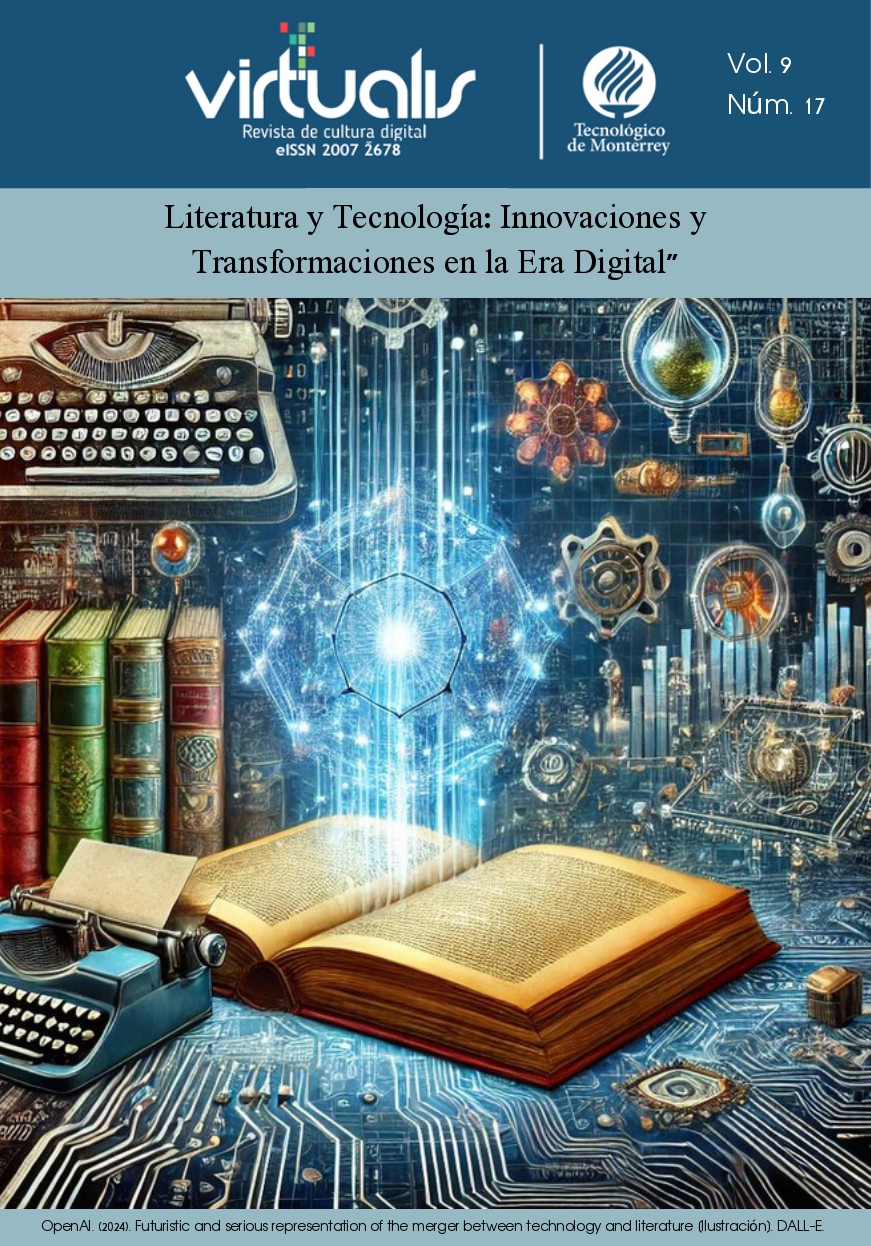Literary social bots and authorship. A contribution from the digital rhetoric
Main Article Content
Following the theoretical framework of the field of the digital rhetoric studies, this article analyzes the problematic of authorship in literary social bots, a digital literature genre. For this, we will use the concept of digital ethos or digital rhetorical persona, derived from the works of Hocks (2003), Warnick (2007), Porter (2009) and Berlanga Fernández, García-García and Victoria Mas (2013). After theoretically delineating the concept of digital ethos, we will analyze how it is constructed in the Twitter account @poem_exe, using the variables postulated by Gutiérrez-Sanz (2016): social or contextual ethos and discursive ethos. The article presents a possible form of analysis for the digital rhetorical persona, a concept that is linked to the one of the author, but is not limited to it.
Aristóteles. (2010). El arte de la retórica. (Traductor, Granero, E.I.). Buenos Aires: Eudeba.
Berlanga Fernández, I., García-García, F., & Victoria Mas, J.S. (2013). Ethos, pathos y logos en Facebook. El usuario de redes: nuevo €œrétor€ del siglo XXI. Comunicar. Revista Científica de Educomunicación, XXI (41), pp. 127-135.
Bolter, J.D. (1991). Writing space: The computer, hypertext, and the history of writing. Hillsdale, NJ: Lawrence Erlbaum.
Boluk, S., Flores, L., Garbe, J., & Salter, A. (2016). Bots. The Electronic Literature Collection. Recuperado de http://collection.eliterature.org/3/collection-bots.html
Dada Poem Generator. (s/f). Recuperado de http://www1.lasalle.edu/~blum/c340wks/DadaPoem.htm
DeVoss, D.N., & Porter, J.E. (2006). Why Napster matters to writing: Filesharing as a new ethic of digital delivery. Computers and Composition, 23(2), pp. 178-210.
Eyman, D. (2015). Digital rhetoric. Theory, method, practice. Ann Arbor: University of Michigan Press.
Ferrara, E., Varol, O., Davis, C., Menczer, F., & Flammini, A. (2015). The Rise of Social Bots. Communications of the ACM, 59(7), 96€“104.
Gache, B. (2015). ¿Qué es la poesía (para un robot)? México: Belén Gache.
Goldsmith, K. (2015). Escritura no-creativa. Gestionando el lenguaje en la era digital. Buenos Aires: Caja Negra.
Gutiérrez-Sanz, V. (2016, abril-mayo-junio). Retórica de los discursos digitales. Una propuesta metodológica para el análisis de los discursos en Twitter. Aposta. Revista de Ciencias Sociales, 69, pp. 67-103.
Heba, G. (1997, enero). HyperRhetoric: Multimedia, literacy, and the future of composition. Computers and Composition, 14, pp. 19-44.
Hocks, M.E. (2003, junio). Understanding visual rhetoric in digital writing environments. College Composition and Communication, 54(4), pp. 629-656.
Kozak, C. (2017). Esos raros poemas nuevos. Teoría y crítica de la poesía digital latinoamericana. El jardín de los poetas. Revista de teoría y crítica de poesía latinoamericana, III (4) (primer semestre), 1-20.
Landow, G.P. (1991). The rhetoric of hypermedia: Some rules for authors. En P. Delaney & G. P. Landow (Eds.), Hypermedia and literary studies. (pp. 81-103). Cambridge, MA: MIT Press.
Landow, G.P. (1995). Hipertexto. La convergencia de la teoría crítica contemporánea y la tecnología. Barcelona: Paidós.
Landow, G.P. (Comp.) (1997). Teoría del hipertexto. Barcelona: Paidós.
Lanham, R.A. (1992). Digital rhetoric: Theory, practice, and property. En M. C. Tuman (Ed.), Literacy online: The promise (and peril) of reading and writing with computers. (pp. 221€“243). Pittsburgh: University of Pittsburgh Press.
Lanham, R.A. (1993). Digital Rhetoric and the digital arts. In The electronic word: Democracy, technology, and the arts. Chicago: University of Chicago Press.
ljcooke. (2017, 24 de septiembre). poem.rb. poemexe. Recuperado de https://github.com/ljcooke/poemexe/blob/master/poem.rb
logopedia. The Emily Dickinson Random Epigram Machine. (s/f). Recuperado de https://logopoeia.com/ed/
Losh, E. (2009). Virtualpolitik. An electronic history of government media-making in a time of war, scandal, disaster, miscommunication, and mistakes. Cambridge: MIT Press.
Montero, A.S. (2012). Los usos del ethos. Abordajes discursivos, sociológicos y políticos. Rétor, 2(2), pp. 223-242.
Olaizola, A. (2013). Postear retórica: análisis de caso de dos publicaciones en la comunidad virtual Taringa! Revista Iberoamericana de Argumentación, 6, pp. 1-38.
Ong, W. (2006). Oralidad y escritura. Tecnologías de la palabra. (Traductora Scherp, A.). Buenos Aires: Fondo de Cultura Económica.
Porter, J.E. (1998). Rhetorical ethics and internetworked writing. Greenwich, CT: Ablex.
Porter, J.E. (2002). Why technology matters to writing: A cyberwriter€™s tale. Computers and Composition, 20, pp. 375-394
Porter, J.E. (2009). Recovering Delivery for Digital Rhetoric. Computers and Composition, 26 (4), pp. 207-224.
Porter, J.E. (2010). Rhetoric in (as) a digital economy. En S. A. Selber (Ed.), Rhetorics and technologies: New directions in writing and communication (pp. 173-197). Columbia, SC: University of South Carolina Press.
Sullivan, P. (2001). Practicing safe visual rhetoric on the world wide web. Computers and Composition, 18(2), pp. 103€“121.
Warnick, B. (2007). Rhetoric online: Persuasion and politics on the world wide web. New York: Peter Lang.
Welch, K. (1990, enero-febrero). Electrifying classical rhetoric: Ancient media, modern technology, and contemporary composition. Journal of Advanced Composition, 10(1), pp. 22-38
Welch, K. (1999). Electric rhetoric: Classical rhetoric, oralism, and a new literacy. Cambridge, MA: MIT Press.
What is micropoetry? (s/f). Micropoetry. Recuperado de http://micropoetry.com/twitter-micropoetry
William Carlos William Poem Generator. (s/f). Recuperado de http://joshmillard.com/wcw/
Wysocki, A.F. (1998). Monitoring order. Kairos: A Journal of Rhetoric, Technology, and Pedagogy, 3(2). Recuperado de http://www.technorhetoric.net/3.2/binder.html?features/wysocki/mOrder0.html
Wysocki, A.F. (2001). Impossibly distinct: On form/content and word/ image in two pieces of computer-based interactive multimedia. Computers and Composition, 18(2), pp. 137-162.
Zappen, J.P. (2005). Digital rhetoric: Toward an integrated theory. Technical Communication Quarterly, 14(3), pp. 319€“325.

 Blog
Blog
 Instagram
Instagram
 Google
Google
 Tec de Monterrey
Tec de Monterrey

